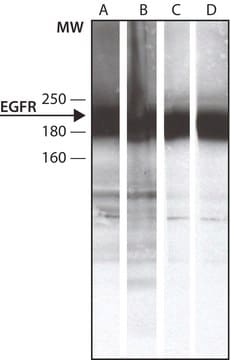16-103
Anti-Phosphotyrosine Antibody, clone 4G10®, Biotin Conjugate
clone 4G10®, Upstate®, from mouse
Sinônimo(s):
4G10 Biotin Antibody, Biotinylated Anti-Phosphotyrosine, Clone 4G10 Anti-Phosphotyrosine
About This Item
Produtos recomendados
fonte biológica
mouse
Nível de qualidade
conjugado
biotin conjugate
forma do anticorpo
purified antibody
tipo de produto de anticorpo
primary antibodies
clone
4G10®, monoclonal
reatividade de espécies
human
reatividade da espécie (prevista por homologia)
all
fabricante/nome comercial
Upstate®
técnica(s)
immunocytochemistry: suitable
immunoprecipitation (IP): suitable
western blot: suitable
Isotipo
IgG2bκ
Condições de expedição
wet ice
modificação pós-traducional do alvo
phosphorylation (pTyr)
Informações sobre genes
human ... PID1(55022)
Descrição geral
Description
Anti-phosphotyrosine monoclonal antibody, clone 4G10 (cat. # 05-321), cross-linked to biotin.
Especificidade
Imunogênio
Aplicação
4 μg of a previous lot, used in conjunction with Streptavidin, agarose conjugate (Catalog # 16-126), immunoprecipitated phosphotyrosine containing proteins from a lysate of EGFstimulated A431 cells.
Note: To preserve phosphotyrosine, add 0.2 mM sodium orthovanadate to the lysis buffer.
Immunocytochemistry:
5-10 μg/mL of a previous lot gave positive immunostaining of EGF-stimulated A431 cells that had been fixed with ethanol:acetic acid [1:1].
Application Notes
For use in applications in which a biotin conjugate is advantageous, such as WB and IC.
Signaling
General Post-translation Modification
Qualidade
Western Blot Analysis:
1:500 dilution of this lot detected Tyrosine phosphorylated proteins on 10 μg of EGF treated A431 lysates.
Descrição-alvo
forma física
Armazenamento e estabilidade
Nota de análise
Pervanadate-treated human A431 cell extracts or EGF-treated human A431 cells
Outras notas
Informações legais
Exoneração de responsabilidade
Not finding the right product?
Try our Ferramenta de seleção de produtos.
Código de classe de armazenamento
12 - Non Combustible Liquids
Classe de risco de água (WGK)
WGK 2
Ponto de fulgor (°F)
Not applicable
Ponto de fulgor (°C)
Not applicable
Certificados de análise (COA)
Busque Certificados de análise (COA) digitando o Número do Lote do produto. Os números de lote e remessa podem ser encontrados no rótulo de um produto após a palavra “Lot” ou “Batch”.
Já possui este produto?
Encontre a documentação dos produtos que você adquiriu recentemente na biblioteca de documentos.
Nossa equipe de cientistas tem experiência em todas as áreas de pesquisa, incluindo Life Sciences, ciência de materiais, síntese química, cromatografia, química analítica e muitas outras.
Entre em contato com a assistência técnica








